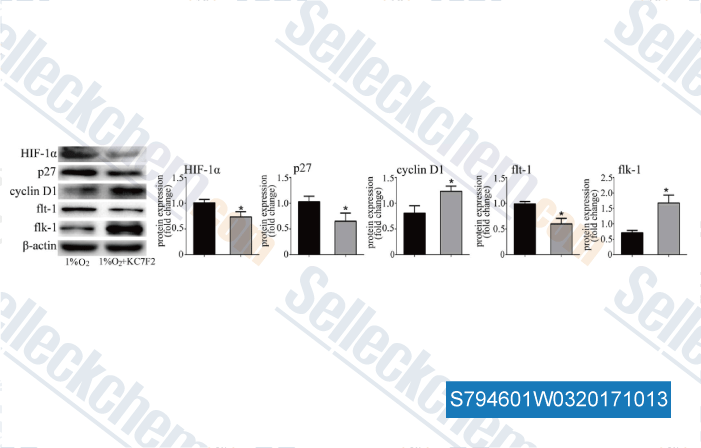|
Toll Free: (877) 796-6397 -- USA and Canada only -- |
Fax: +1-832-582-8590 Orders: +1-832-582-8158 |
Tech Support: +1-832-582-8158 Ext:3 Please provide your Order Number in the email. |
Technical Data
| Formula | C16H16Cl4N2O4S4 |
||||||||||||||
| Molecular Weight | 570.38 | CAS No. | 927822-86-4 | ||||||||||||
| Solubility (25°C)* | In vitro | DMSO | 100 mg/mL (175.32 mM) | ||||||||||||
| Water | Insoluble | ||||||||||||||
| Ethanol | Insoluble | ||||||||||||||
| In vivo (Add solvents to the product individually and in order) |
|
||||||||||||||
|
* <1 mg/ml means slightly soluble or insoluble. * Please note that Selleck tests the solubility of all compounds in-house, and the actual solubility may differ slightly from published values. This is normal and is due to slight batch-to-batch variations. * Room temperature shipping (Stability testing shows this product can be shipped without any cooling measures.) |
|||||||||||||||
Preparing Stock Solutions
Biological Activity
| Description | KC7F2 is a selective HIF-1α translation inhibitor with IC50 of 20 μM in a cell-based assay. | ||
|---|---|---|---|
| Targets |
|
||
| In vitro | KC7F2 inhibits HIF-1α protein synthesis but not its mRNA transcription. KC7F2 inhibits HRE-driven transcription and decreases HIF-1α protein levels in LN229-HRE-AP cells. KC7F2 shows a dose-response cytotoxicity with IC50 of approximately 15 to 25 μM in cancer cells MCF7, LNZ308, A549, U251MG, and LN229. In D54MG glioma cells, KC7F2 inhibits colony formation, especially under hypoxia. [1] In hypoxic microglial cultures, KC7F2 downregulates the expression of TfR and DMT, and reduces the HIF-1α mediated iron accumulation. [2] |
||
| In vivo | KC7F2 significantly reduces the latent period in the pentylenetetrazole kindling rat model and increases the rate of spontaneous recurrent seizures during the chronic stage. [3] |
Protocol (from reference)
| Kinase Assay: |
|
|---|---|
| Cell Assay: |
|
References
|
Customer Product Validation

-
Data from [Data independently produced by , , Respir Physiol Neurobiol, 2017, 247:87-95]
Selleck's KC7F2 has been cited by 37 publications
| Hypoxia-induced DTL promotes the proliferation, metastasis, and sorafenib resistance of hepatocellular carcinoma through ubiquitin-mediated degradation of SLTM and subsequent Notch pathway activation [ Cell Death Dis, 2024, 15(10):734] | PubMed: 39384740 |
| Paeonol prevents sepsis-associated encephalopathy via regulating the HIF1A pathway in microglia [ Int Immunopharmacol, 2024, 143(Pt 1):113287] | PubMed: 39362015 |
| SENP1 reduces oxidative stress and apoptosis in renal ischaemia-reperfusion injury by deSUMOylation of HIF-1α [ J Cell Mol Med, 2024, 28(16):e70043] | PubMed: 39205481 |
| Hypoxia-inducible factor-1α attenuates renal podocyte injury in male rats in a simulated high-altitude environment by upregulating Krüppel-like factor 4 expression [ Exp Physiol, 2024, 10.1113/EP091443] | PubMed: 38774964 |
| Inhibiting the glycerophosphodiesterase EDI3 in ER-HER2+ breast cancer cells resistant to HER2-targeted therapy reduces viability and tumour growth [ J Exp Clin Cancer Res, 2023, 42(1):25] | PubMed: 36670508 |
| Hypoxia Primes Human ISCs for Interleukin-Dependent Rescue of Stem Cell Activity [ Cell Mol Gastroenterol Hepatol, 2023, 10.1016/j.jcmgh.2023.07.012] | PubMed: 37562653 |
| Hypoxia Primes Human ISCs for Interleukin-Dependent Rescue of Stem Cell Activity [ Cell Mol Gastroenterol Hepatol, 2023, 16(5):823-846] | PubMed: 37562653 |
| Dimethyloxalylglycine Attenuates Steroid-Associated Endothelial Progenitor Cell Impairment and Osteonecrosis of the Femoral Head by Regulating the HIF-1α Signaling Pathway [ Biomedicines, 2023, 11(4)992] | PubMed: 37189610 |
| Identification of Hif1α as a Potential Participant in Autoimmune Uveitis Pathogenesis Using Single-Cell Transcriptome Analysis [ Invest Ophthalmol Vis Sci, 2023, 64(5):24] | PubMed: 37227746 |
| Targeting SELPLG/P-selectin glycoprotein ligand 1 in preclinical ARDS: Genetic and epigenetic regulation of the SELPLG promoter [ Pulm Circ, 2023, 13(1):e12206] | PubMed: 36873461 |
RETURN POLICY
Selleck Chemical’s Unconditional Return Policy ensures a smooth online shopping experience for our customers. If you are in any way unsatisfied with your purchase, you may return any item(s) within 7 days of receiving it. In the event of product quality issues, either protocol related or product related problems, you may return any item(s) within 365 days from the original purchase date. Please follow the instructions below when returning products.
SHIPPING AND STORAGE
Selleck products are transported at room temperature. If you receive the product at room temperature, please rest assured, the Selleck Quality Inspection Department has conducted experiments to verify that the normal temperature placement of one month will not affect the biological activity of powder products. After collecting, please store the product according to the requirements described in the datasheet. Most Selleck products are stable under the recommended conditions.
NOT FOR HUMAN, VETERINARY DIAGNOSTIC OR THERAPEUTIC USE.
